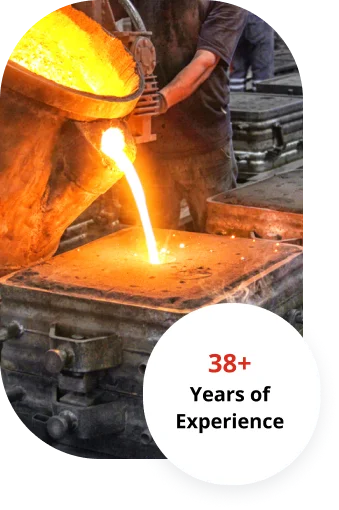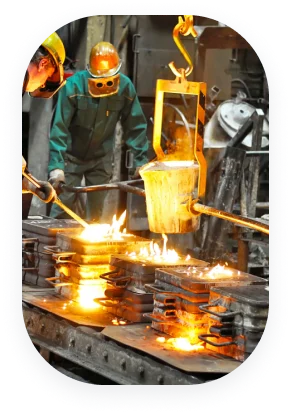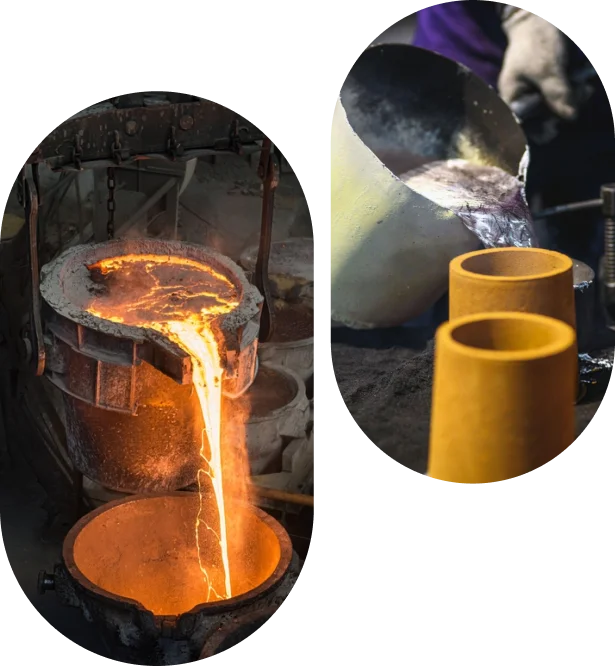

Casting and Foundry is a process of melting metal and casting it in molds to create parts such as engine components, machine cases, valves, and gears. All these processes use different types of casting methods like die-casting, investment casting, and sand casting.
Modern foundries work with sophisticated, mechanized equipment that melts metals in furnaces of a few kilograms to several tons. After the molten metal is cast into moulds, it solidifies into the desired form when cooled. Finishing operations make these castings ready for production and up to standards of quality.
Managing such complex workflows from raw material procurement (like pig iron, aluminum, epoxy, or clay) to melting, molding, cooling, and last stage finishing needs more than a manual tracking. It needs a smart ERP solution specifically designed for the Casting & Foundry industry.
Lighthouse ERP for Casting and Foundry Industry is designed to digitize and automate the entire production lifecycle. It streamlines operations, improves traceability, and ensures accurate material resource planning. Built with flexibility and scalability, it adapts to your foundry’s unique processes, making it an essential tool in today's competitive and tech-driven manufacturing environment.

Managing diverse raw materials like pig iron, scrap, and alloys needs precise control and accurate ratios which can be achieved with Foundry ERP Software.
Ensuring backward and forward traceability of batches based on heat number, mold number, or furnace cycle is critical for defect analysis, recalls, and quality audits.
Even with mechanization, many foundries still face challenges in monitoring furnace parameters like temperature, timing, and metal flow rate, affecting casting consistency.
Sand, epoxy, and clay molds often result in high material wastage due to errors in preparation, humidity control, or pour timing increasing costs and reducing yield.
Movements of molten metal, molds, semi-finished castings, and finished parts between yard, weighbridge, furnace, and lab are very specific to foundry layout.
Movements of molten metal, molds, semi-finished castings, and finished parts between yard, weighbridge, furnace, and lab are very specific to foundry layout.
Melting furnaces and mold handling systems face frequent wear and tear, and lack of predictive maintenance leads to unscheduled downtime and production loss.
Foundry metal control handles multiple raw material grades like pig iron, scrap, aluminium, and tracks heat-wise combinations, minimizing wastage and rejections.
With metal pour control software, monitor furnace temperature, pour cycles, and metal fluidity helping avoid defective casting due to improper pouring.
ERP for sand casting tracks mould usage, lifecycle, and material like epoxy or clay, helping reduce repeated rework and mould- related scrap.
ERP for foundry integrates yard logistics, weighbridge, furnace, and quality lab, ensuring clear visibility of casting and metal batches across plant units.
Captures real-time data on sprue, runner, and excess metal, helping calculate net yield and improving scrap-to-finish ratio.
Foundry ERP includes preventive maintenance for ladles, crucibles, moulding machines, reducing unexpected downtimes and improving asset life.
Cost calculations are linked to mould type, alloy used, time taken, and labour hours, ensuring accurate job casting for each casting.

Inventory Management allows the company to easily keep the track of inventory of raw material to finished goods along with the quality status of produced goods helping in managing the inventory costs effectively.
Procurement Management lets the company monitor all the raw material purchased along with other necessary material like store consumable, which is required for working of industry.
Sales & Dispatch Management module allows the company to track all the orders and shipments (under process and out for delivery) based on the details of delivery orders. Timely Reporting through emails/ SMS for better customer service
The Plant Management module facilitates the management workers and team to assimilate the problems in the plant and mitigate all the problems that occur during the plant maintenance.
Finance Management helps the company manage its finances and accounts rendering them the complete understanding of the budget and costing of production along with operations profitability
Quality Control and Calibration Management helps the team to know the quality of the production, leading the production team to track defects (casting rejections and machining rejections) and undertake improvements in the flawed products as necessary. It also helps in inspection of any re-working based on casting inspection, machining inspection or die inspection.
Lighthouse ERP connects all critical departments procurement, production, furnace, mold room, quality, and dispatch creating a unified digital workflow and eliminating data silos.
Automates key casting processes such as melting, pouring, mold tracking, and cooling schedules, reducing manual errors and speeding up production cycles.
Every metal melt and casting batch is traceable through assigned heat numbers, lot IDs, and pour details, improving quality control and accountability.
Handles complex inventory like pig iron, aluminum, scrap, epoxy, clay, and tracks sprue, runner, and excess metal for accurate material planning and scrap reuse.
Tracks each stage of casting from furnace temperature, pour timings, to mold curing enabling floor supervisors to react immediately to process deviations.
Schedules maintenance alerts for furnaces, ladles, die-casting machines, and crucibles, reducing downtime and increasing machinery life.
In-built analytics engine processes data from casting operations and provides actionable insights for process optimization, cost control, and quality improvements.
Captures inspection data, connects it with casting parameters, and helps in reducing casting defects like shrinkage or porosity.
Calculates casting-wise costing by factoring in raw material, labor, machine hours, and energy used, supporting more accurate quotations and profitability analysis.